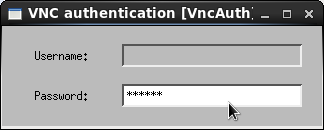

- TIGERVNC CLIENT WINDOWS HOW TO
- TIGERVNC CLIENT WINDOWS INSTALL
- TIGERVNC CLIENT WINDOWS UPDATE
- TIGERVNC CLIENT WINDOWS MANUAL
- TIGERVNC CLIENT WINDOWS FULL
The basic steps included in this tutorial are available in the shell script at ol8-vnc-setup.sh More Learning ResourcesĮxplore other labs on /learn or access more free learning content on the Oracle Learning YouTube channel. Tiger VNC Server configuration documentation in.
TIGERVNC CLIENT WINDOWS INSTALL
Install and Configure VNC on Oracle Linux 8 For More Information

The video demonstration and tutorial provided at may also be useful if you need more information on configuring a VNC server. Install a GNOME desktop environment and all of its dependencies.

If you run the viewer with no arguments it will prompt you for a VNC server to connect to. VNC saves your desktop session and allows you to connect to it later.
TIGERVNC CLIENT WINDOWS MANUAL
This manual page documents version 4 for the X window system. To access an X Windows display from a remote computer, install and connect a VNC client. tigervnc file DESCRIPTION vncviewer is a viewer (client) for Virtual Network Computing.
TIGERVNC CLIENT WINDOWS UPDATE
TigerVNC Server was rebased from 1.9.0 to 1.10.1 in Oracle Linux 8 Update 3. Some alternative software is listed at the end of the tutorial. However, you can use a different VNC software of your choice.
TIGERVNC CLIENT WINDOWS HOW TO
This tutorial uses TigerVNC to illustrate how to remotely connect to systems. VNC is suitable for thin client computing where multiple dumb terminals can share the same hardware resources that are hosted on an Oracle Linux server. You can connect to a VNC server by using any compatible software client. VNC is particularly useful for remotely controlling Oracle Linux servers that have a graphical desktop environment installed. Virtual Network Computing (VNC) is a graphical desktop sharing system that controls remote machines by sending keyboard and mouse events over the network.
TIGERVNC CLIENT WINDOWS FULL
This tutorial is targeted at users of Oracle Linux 8 or later. Lots of changes have been made since the last release, but the highlights are: The clipboard now supports full Unicode in the native viewer, WinVNC and Xvnc/libvnc. This tutorial shows you how to install and set up the VNC remote access server software on an Oracle Linux system to enable you to remotely operate a graphical desktop environment. Install the VNC Remote Access Server on Oracle Linux Introduction Most people using TigerVNC will be best off using port 5920.JavaScript must be enabled to correctly display this content In the Server field, enter .au: port, where port is the port you want to use.


 0 kommentar(er)
0 kommentar(er)
